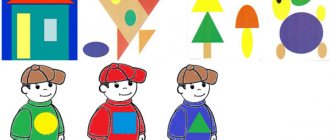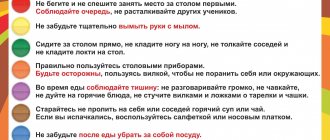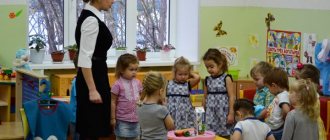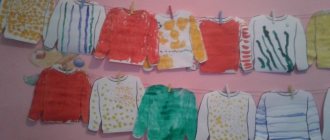Summary of GCD on the formation of elementary mathematical concepts in the middle group
Summary of GCD on FEMP in the middle group “Magic Teremok”
Program tasks: • Fix the names of geometric shapes (circle, triangle, square);
• Strengthen the ability to correlate the number of objects with a number;
• Improve counting skills within 5; • Develop memory, speech, logical thinking, imagination; • Foster independence, the ability to understand the learning task; • Develop the ability to help, friendly relationships. Equipment: Demonstration material: bibabo doll - mouse, cards with numbers and subject pictures, geometric shapes (circle, square, triangle, rectangle)
, toys
(five cubes, four nesting dolls, three bears, Masha and the bear, one hedgehog)
, four hoops , tambourine
Handouts: geometric shapes (circle, square, triangle, rectangle)
, cards with numbers.
Integration of educational areas: communication, reading fiction, health, physical education. Progress of the NOD: Educator: Children, look who came to visit us today? Mouse: Hello, guys. Do you recognize me? I am the Little Mouse from the fairy tale “Teremok”. Listen to what happened to me today. I ran to the tower, stopped and asked: “Terem-teremok! Who lives in the mansion? And the magical voice at the tower answers: “The tower will open its door only to those who complete all my tasks.” Will you help me complete the tasks given by the magical Teremok? And the tasks are as follows: Task No. 1.
“Name the geometric shapes”
- What is this?
(Square)
- Who can name this figure?
(Rectangle)
- Look carefully and tell me how a rectangle differs from a square?
(children's answers)
- How can I check?
(Place them on top of each other)
- What do we see now?
What can we say? (Two sides of a rectangle are longer than a square, and the other two are identical)
- What is the difference between a square and a triangle?
(A triangle has three angles and three sides, and a square has four angles and four sides)
- What is the difference between a circle and a square?
(A circle has no corners or sides) Task No. 2.
“Show it correctly”
(The teacher names geometric shapes, and the children pick up the geometric figure that the teacher names). Task 3.
“Find a place for the figure”
(There are four hoops on the floor, in the center of each there is a geometric figure. The teacher gives the children one geometric figure each) Educator: While I am banging the tambourine, you walk in different directions. As soon as the tambourine is silent, you need to find a hoop with your geometric figure and stand around it. (The game is repeated several times, with the children changing their figures) Task No. 4.
“Hit the tambourine as many times as the number shows”
(The teacher raises the card with the number, the child must hit the tambourine as many times as the number shows).
Physical education minute.
The cubs lived in the thicket, twisting their heads: Like this, like this
(circular movements of the head)
They twisted their heads.
The cubs were looking for honey, Together they rocked the tree: Like this, like this (raise your arms up and bend to the sides)
Together they rocked the tree.
And then they walked (walking like a bear)
and drank water from the river: Like this, like this
(body bends forward)
And they drank water from the river.
And then they danced, (“springs”)
raised their paws higher: Like this, like this
(jumping, clapping their hands at the top)
raised their paws higher.
Task No. 5.
“Count correctly”
(The teacher puts object pictures on the easel. Children must correctly correlate the number of objects with the number). Task No. 6.
“Find a house for each number”
(The teacher distributes a card with a number to each child. On five tables there are toys: five cubes, four nesting dolls, three bears, two heroes from the fairy tale “Masha and the Bear” and one hedgehog. The teacher distributes them to the children cards with a number and shows five houses where toys live. At a signal, the children find the house for their number and stand near it. The teacher together with the children checks whether everyone has found their house correctly.
You can exchange cards and play a few more times).
Educator: Guys, you completed all the tasks correctly, so the doors of the magic tower are open for the Little Mouse. Let's say goodbye to the Mouse, she needs to hurry to her fairy tale. And if Little Mouse needs our help again, we will definitely help her. Really, guys? Mouse: Thanks, guys. You helped me a lot. Goodbye. Educator: Who came to visit us today? What happened to her? How could we help her? What tasks did we complete? Did you enjoy helping Little Mouse? (Children's answers).
We recommend watching:
Summary of a lesson on the formation of mathematical concepts for children of the middle group. Notes of educational activities on cognitive activity (mathematics) in the middle group. Our flag Notes on mathematics in the middle group Notes on cognitive development in the middle group of kindergarten
Similar articles:
Math lesson notes “Number 1”. Middle group
Summary of mathematics lesson “Number 2” in the middle group
Summary of mathematics lesson “Number 3” in the middle group
Summary of mathematics lessons in the middle group. Digit 4
A selection of ideas and author's developments according to the Federal State Educational Standard
Topic options for the middle group
The teacher can choose any topic for open viewing. Fairy-tale themes are very popular, when all tasks are played out around the plot of a specific fairy tale, well known to students in the middle group (“Teremok”, “Kolobok”, “Geese-Swans”, “The Three Little Pigs”, “Little Red Riding Hood”). Such an activity may have a name, for example, “Visiting a Fairy Tale.”
The content of educational activities can also include motifs from different fairy tales, when children travel through fairy tales, helping the heroes of each of them. This activity can be called “Journey through Fairy Tales” or “Fairytale Kaleidoscope”.
The theme for the lesson can also be the plot of a cartoon (“Three from Prostokvashino”, “Visiting Winnie the Pooh”).
An original idea is to prepare a plot play, a mini-play, where preschoolers will play the role of, for example, geometric figures, talking about themselves and their properties (“Country of Figures,” “Kingdom of Mathematics,” etc.). And during the course of such a performance, the children will be offered interesting tasks.
An open mathematical lesson can be associated with natural history topics, the study of animals, birds, insects, plants (“Mathematics in the forest”, “Pets”, “River Travel”, etc.).
On the eve of a holiday, you can introduce a holiday theme into an open math lesson and designate it, for example, as “Gifts for Moms” (with appropriate gifts - beads made of geometric shapes, etc.).
The theme of the open math lesson can be associated with International Women's Day and gift beads made of geometric shapes to mothers
Ideas for a motivating start
For middle school students, the play component of math classes is of paramount importance. It should be present from the very beginning of educational activities in order to stimulate the cognitive activity of children. In this case, the teacher can use various types of motivation.
You can start the lesson with a surprise moment - an unusual guest suddenly appears and brings interesting tasks for the children. For example, Carlson (a toy or a disguised adult or child from a preparatory group) “flies” into a group room and tells the kids that he wants to play pranks with them.
You can start the lesson with a surprise moment - the appearance of a famous fairy-tale hero
Another option is that Mishka comes to the children from the forest, who has woken up and is trying to figure out what time of year it is. While Mishka was sleeping, he dreamed of riddles, games and interesting mathematical tasks, which he brought to the children in an envelope.
The motive of helping also works well. For example, in the process of traveling through fairy tales, children help different characters out of trouble. For Little Red Riding Hood, the wolf tore the beads she was carrying as a gift to her grandmother - preschoolers lay out new ones from geometric shapes. The bear destroyed the little house, and now the forest animals have nowhere to live - the kids are building a new one.
Bunny comes to visit the guys; he has a misfortune - the house in which he lives has broken down. To help the bunny find and repair his house, you need to make your way through the forest, overcoming various obstacles.
Toy hero asks children for help
An interesting solution: a balloon appears in front of the guys, who lives in the country of Mathematics and asks to help him return home.
Doll Katya reports that March 8 is coming soon, but she doesn’t know what gift to please her mother with. Preschoolers present mathematical gifts: again, beads from geometric shapes, lay out flowers on a magnetic board, etc.
Children always happily accept the offer to travel. For example, to the magical country of Igrandia, where there are many interesting activities and entertainment (and the Umnyashka doll calls them there).
A famous fairy-tale hero, for example, Kolobok, invites the children into his fairy tale. To find themselves there, the teacher invites the children to perform “magic” actions - stand in a circle, close their eyes, clap their hands, turn around themselves.
To get into a fairy tale, you need to perform certain magical actions
Another motive that also works well with middle school students is to teach a magical character something, because he himself cannot do it. For example, Dunno comes to preschoolers and tells them that he can’t count, doesn’t recognize shapes, and asks them to teach him this. Of course, kids will happily respond to such a request, because it makes them feel important and independent.
An interesting idea is to tell the children a short fairy tale at the beginning of the lesson, which the teacher can easily compose himself. For example, a lesson dedicated to geometric shapes can start with such a magical story.
In the land of geometric shapes lived the Square and the Rectangle. Rectangle considered himself ugly and clumsy. If he stands up to his full height, he looks tall and narrow, and lying on his side, he looks fat and short. The square was proud of itself: its sides are equal, and it looks the same no matter how it turns. But one day a little girl got lost in the forest. She met the heroes and turned to them for help. The girl needed to climb higher to see where her house was. Having climbed the Square, she saw nothing. When the modest Rectangle stood up to its full height, the girl found herself very high and saw where she needed to go. Friends went to see the baby off. There was a river on their way. Square could not help the girl cross the river - he flopped into the water, and Rectangle lay on his side and turned into a bridge. The girl ran across it and ended up at home. Now the hero knew that he was a necessary and useful figure.
Illustration for a fairy tale about geometric shapes
Table: fragments of notes from open classes on FEMP in the middle group
| Author and theme of GCD | Progress of the lesson |
| Velgosha N.I. “Let's help friends” (open lesson using ICT) | The teacher informs the children that the heroes of one fairy tale came to visit them (slide with characters from the fairy tale “Teremok”). The guys go into a fairy tale (stand in a circle, close their eyes, clap their hands three times and spin around themselves). A mouse appears (slide). She will be able to get into the tower only if she completes the task. Flowers of different colors and sizes grow near the tower. For each flower you need to plant a butterfly of the appropriate size. The mouse is allowed into the house (every time the little animal is allowed into the house, a slide appears on the screen). A task to help the frog (slide) - the game “Wonderful Bag”. Children take turns taking out geometric shapes, naming them and matching them with the shapes lying on their plates. Task “Complete the figure.” Slide with a picture of a bunny. Preschoolers must count how many times the bunny will knock on the drum and show the corresponding number. Slide with a fox. She loves to dance - physical education is being held. Slide with the Wolf. There is a large lock hanging on the door of the house, the key to which has been lost. You need to lay it out from counting sticks according to the proposed pattern. Assignment from the Bear (slide). He slept for so long that he mixed up the parts of the day and believes that it is light at night and dark during the day. A word game is being played: “Finish the sentence.”
All the animals end up in the little house. Now they will live cheerfully and amicably. The children say magic words together with the teacher and find themselves back in kindergarten. The lesson is summed up: the children discuss who helped the animals and which of the animals they liked the most. |
| Maksimova E.A. “Mishutka visiting the guys” | Riddle about a bear: He slept all winter in a fur coat, sucked a brown paw, and when he woke up, he began to roar. This forest animal... (bear) A toy Bear appears, who slept all winter and cannot determine what time of year it is. He also had a dream with various mathematical games, riddles and tasks. They are in an envelope. Children guess riddles about the parts of the day:
A physical education session is held:
Mishka suggests playing the word game “Finish the Sentence”:
Mishka offers to play football: the children sit down at the tables. A sheet of green cardboard is a football field with a ball on it. As instructed by the teacher, the children place the ball in the middle of the playing field, in the upper corner on the right, etc. The task is to count four yellow sticks and think about what geometric figure can be made from them (preschoolers lay out a square). Another stick is added, the guys count to five and back. Satisfied, Mishutka leaves. |
| Kozlova I.G. “Let’s help Sharik return to the country of Mathematics” | The teacher tells the children that on the way to kindergarten she found a box. From there she takes out geometric shapes - a square, a circle and a triangle. The teacher also takes a balloon out of the box and reads a poem about it: I’m inflating a balloon. I roll it like a ball, throw it up, catch it again. I look at his form. It is round, just like a flat circle. But he is a great friend to everyone around. The same shape is an orange, a watermelon, a ball, and a tangerine. I will call the figure that I can roll a ball. It turns out there is still a note in the box. It says that the ball is lost and wants to return to its home country of Mathematics. The guys should help him. "Find the ball" task. The balloon is sad because it has no friends. You need to help him - find objects of a similar shape to him in the proposed picture. Children call a snowman, a soccer ball, a New Year's ball. Game "What's rolling?" The teacher is interested in how you can get to the country of Mathematics (train, bus, etc.). A train with square wheels is on display. An experiment is being carried out: two guys roll a ball and a cube from one line to another. Children come to the conclusion that only a ball can roll, because it has no corners. The task is in the exercise of counting to 3. Trees grow in the forest: fir trees, birches, oaks (a picture is shown). The children, as directed by the teacher, name the first tree, the second and the third. Then, on the contrary, they answer what kind of spruce, etc. A physical education session “Maple” is held: The wind quietly shakes the maple, tilts to the right, to the left: One - tilt and two - tilt, The maple leaves rustled. Individual task. Each child has a picture of three trees. You need to color the first tree red, the second yellow, and the third green. At the end of the fairy forest there is a door to the country of Mathematics. You need to pick up the keys to the lock. The children are asked to cut a strip with the image of keys and attach them to the locks with the corresponding number. Now you can read the code - 3,1,2. Now the door is open and the balloon goes to its home. |
| Gilmetdinova G.S. "Balloon Journey to the Land of Mathematics" | Riddle about a hot air balloon: My beloved warm air, You work wonders with me, And like in a wonderful fairy tale, I rise to the skies. The hot air balloon invites preschoolers to go on a journey on it. To take a seat in the basket, you need to find a chair with a geometric shape, like on the ticket (it is issued to each child). Stop "Magic Forest". Apple trees grow here. You need to count how many large and small apples are on the apple tree (5 each), collect them separately in two baskets, check their number (put the small ones under the large ones). May beetles live under the apple tree. The teacher asks to find two identical beetles. There are many Christmas trees growing in the clearing. Children must find the lowest and highest. Then it is proposed to build a serial row in height, starting with the tallest tree. Ball game. The teacher throws the ball to the preschoolers one by one, asking questions:
The next task is for the guys to count with their eyes closed how many times the bell rings (several times). A strong wind began. In order for it to subside, you need to correctly complete the task - find an extra geometric figure in the row. The wind subsides, the children in the balloon return to kindergarten. The teacher gives them balloons as a keepsake of the trip. |






